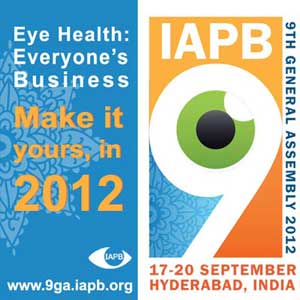IAPB, 9th General Assembly
Eye Health: Everyone’s Business
September 17-20, 2012 Hyderabad, India
The IAPB is an umbrella coordinating organization of over 120 members which was founded in 1978 by Sir John Wilson for the reduction, prevention of avoidable blindness and visual impairment, especially in the developing world. Under Dr. Mario Tarizzo the World Health Organization’s Programme for the Prevention of Blindness was established in 1978. These two organizations started the global initiative Vision 2020, The Right to Sight in February 1999 to eliminate the main causes of avoidable blindness in order to give all people in the world, particularly the millions of needlessly blind, the right to sight. The strategy of Vision 2020 is built upon a foundation of community participation, with three essential components:
- Cost-effective DISEASE CONTROL interventions
- HUMAN RESOURCE DEVELOPMENT ( training and motivation ).
- INFRASTRUCTURE DEVELOPMENT ( facilities, appropriate technology, consumables, funds ).
Below I would like to share some observations/lessons learned while recently attending the IAPB 9GA meeting in Hyderabad, India. These notes represent the thoughts /opinions/publications of many speakers/organizations. I have borrowed freely from many of the speakers for this summation.
- Non-communicable diseases ( NCD ) are the single biggest cause of deaths worldwide. NCDs include CVD, diabetes, cancer, COPD, tobacco usage, excess alcohol, etc. With tobacco usage, there is an increased incidence of cataracts, glaucoma, and ARMD. In Australia, there has been a media campaign with the message: Smoking Causes Blindness. Check out the website. I have printed one of their posters to display in my eye clinic in Belize.
- More diabetics worldwide will live into old age. Diabetics are 25 times more likely to go blind. Currently, 84% of the world population resides in the developing world. By 2050, 80% of the elderly will live in developing countries. The potential adverse interaction between uncontrolled diabetes, hyperlipidemia, and hypertension need to be publicized widely. International Diabetes Federation < www.idf.org.> is an umbrella organization for many diabetic associations.
- There was a lot of discussion about sustainability eye programs. Various successful models from around the world were presented. Usually a three-tier system: 1. the poor receive free eye care/surgery. 2. the financial middle class receive subsidized services, and the wealthy pay a larger ( full ) amount sometimes with ” special treatment ” but everyone receives high-quality care. The cost for an eye visit ( exam ) is no more that one day’s pay and the cataract surgery cost is no more that one month’s pay (salary).
- Cataract surgery coverage in the developing world is usually worst in rural areas. Most of the ophthalmic care (providers/infrastructure) is concentrated in the larger cities and the overwhelming need/population is usually in rural areas. Who is usually underserved are women and the poor in rural areas? ( What else is new ) ?
- Cataract surgery coverage ( CSC ) is a coverage indicator. Uses the operated persons in the community as the denominator. Measures accessibility and utilization of services at the community level. It requires a population-based survey which is usually expensive.
- If there had been no WHO / IAPB / Vision 2020 interventions then the blindness ( <6/60 or < 10 degree V. field ) prevalence prediction was 76 million by 2020. However, the most recent 2010 WHO figures are 39 million blind ( < 6/ 60 ) , 246 million with low vision ( < 6/ 18 ), for a total of 285 million. The top five causes of blindness worldwide are cataracts, uncorrected refractive errors ( URE ), glaucoma, childhood blindness, and diabetes. Unfortunately, many patients are still blind after cataract surgery. Ongoing success stories are onchocersiasis, trachoma, vitamin A ( xerophthalmia ) deficiency, and cataracts in some places like India.
- The barriers to achieving the goals of Vision 2020 in middle-level ( developing ) countries are mainly political. Need increased commitment of national governments. Now we need serious discussions with national Ministries of Health. Governments must buy-in.
- Cataract surgical rate ( CSR ) represents the number of cataracts operations ( eyes ) per million population per year. A good indicator of output. CSR requires proper record keeping to know where patients reside, etc. Country-level CSR often hides regional inequalities. So what is the ideal CSR? Target CSR should at least equal annual incidence of cataract. Otherwise, the cataract backlog may increase. Different V.A. criteria for cataract diagnosis will require different CSR’s. For many developing countries a CSR between 1500 to 2000 is ideal. Often difficult to determine true CSR as providers ( surgeons ) sometimes reluctant to reveal their CSR.
- Primary health care and primary eye care ( PEC ) go together. So what is PEC? : access to clean drinking water ( decrease trachoma ), increase vaccination ( decrease blindness from measles ), prolonged breastfeeding/infant weighing ( decrease xerophthalmia ), increase CSR ( decrease poverty, increase/prolong schooling for children in that family unit ).
- The International Society of Geographical and Epidemiological Ophthalmology met after the main IAPB meeting with a theme of Vision 2020 – The Countdown Begins. Professor Allen Foster gave Elizabeth Cass Oration 2012: Neglected Tropical Diseases and Vision 2020.
- Non-compliance for glasses is almost 100% in children with small refractive errors ( -1.00 to + 1.00 D ) The higher the refractive error, the more likely the child is to wear glasses. Compliance is less after 6 months compared to one month. Girls are more likely to wear glasses than boys.
More to come. Hope some of this is useful.
Baxter McLendon MD

